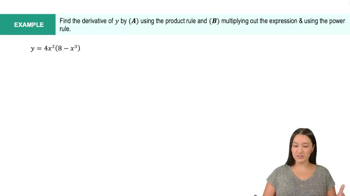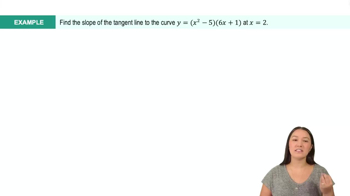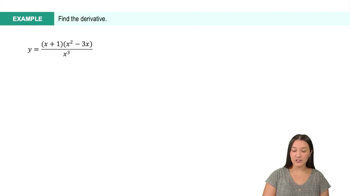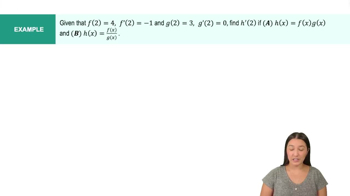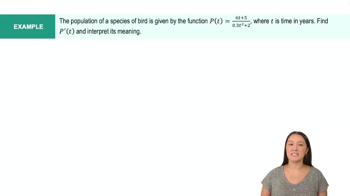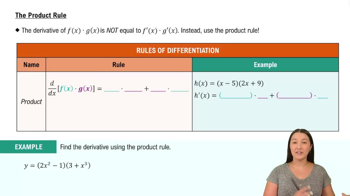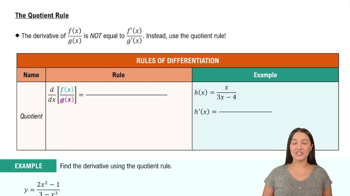Table of contents
- 0. Functions7h 52m
- Introduction to Functions16m
- Piecewise Functions10m
- Properties of Functions9m
- Common Functions1h 8m
- Transformations5m
- Combining Functions27m
- Exponent rules32m
- Exponential Functions28m
- Logarithmic Functions24m
- Properties of Logarithms34m
- Exponential & Logarithmic Equations35m
- Introduction to Trigonometric Functions38m
- Graphs of Trigonometric Functions44m
- Trigonometric Identities47m
- Inverse Trigonometric Functions48m
- 1. Limits and Continuity2h 2m
- 2. Intro to Derivatives1h 33m
- 3. Techniques of Differentiation3h 18m
- 4. Applications of Derivatives2h 38m
- 5. Graphical Applications of Derivatives6h 2m
- 6. Derivatives of Inverse, Exponential, & Logarithmic Functions2h 37m
- 7. Antiderivatives & Indefinite Integrals1h 26m
- 8. Definite Integrals4h 44m
- 9. Graphical Applications of Integrals2h 27m
- 10. Physics Applications of Integrals 2h 22m
3. Techniques of Differentiation
Product and Quotient Rules
Problem 3.4.70
Textbook Question
Higher-order derivatives Find f′(x),f′′(x), and f′′′(x).
f(x) = 1/x
 Verified step by step guidance
Verified step by step guidance1
Step 1: Identify the function f(x) = \frac{1}{x}. This can be rewritten using exponent notation as f(x) = x^{-1}.
Step 2: Find the first derivative f'(x) by applying the power rule. The power rule states that if f(x) = x^n, then f'(x) = n \cdot x^{n-1}. For f(x) = x^{-1}, f'(x) = -1 \cdot x^{-2}.
Step 3: Simplify the expression for the first derivative. f'(x) = -x^{-2} can be rewritten as f'(x) = -\frac{1}{x^2}.
Step 4: Find the second derivative f''(x) by differentiating f'(x) = -x^{-2} again using the power rule. f''(x) = 2 \cdot x^{-3}.
Step 5: Simplify the expression for the second derivative. f''(x) = 2x^{-3} can be rewritten as f''(x) = \frac{2}{x^3}.
 Verified video answer for a similar problem:
Verified video answer for a similar problem:This video solution was recommended by our tutors as helpful for the problem above
Video duration:
4mPlay a video:
Was this helpful?
Key Concepts
Here are the essential concepts you must grasp in order to answer the question correctly.
First Derivative
The first derivative of a function, denoted as f'(x), represents the rate of change of the function with respect to its variable. For the function f(x) = 1/x, the first derivative can be found using the power rule or quotient rule, indicating how the function's value changes as x varies.
Recommended video:
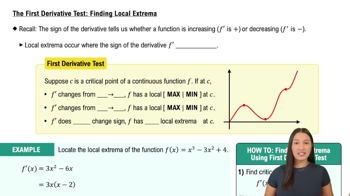
The First Derivative Test: Finding Local Extrema
Second Derivative
The second derivative, denoted as f''(x), is the derivative of the first derivative. It provides information about the curvature of the function and can indicate concavity. For f(x) = 1/x, calculating the second derivative involves differentiating f'(x) again, revealing how the rate of change itself is changing.
Recommended video:

The Second Derivative Test: Finding Local Extrema
Higher-Order Derivatives
Higher-order derivatives refer to derivatives taken multiple times. The third derivative, f'''(x), is the derivative of the second derivative and can provide insights into the behavior of the function beyond just its slope and curvature. For f(x) = 1/x, finding the third derivative involves a systematic application of differentiation rules to the second derivative.
Recommended video:
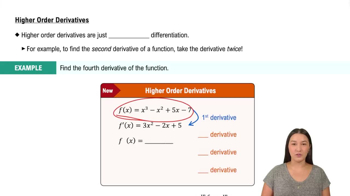
Higher Order Derivatives
Related Videos
Related Practice



